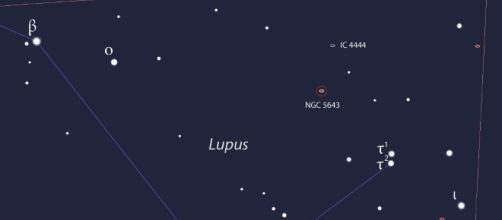A supernova known as 2017 cbv was discovered in the direction of the southern constellation Lupus, within the spiral galaxy NGC 5643. This galaxy is located at approximately 60 million light years from earth. The luminosity from the explosion of this astronomical phenomenon has been getting brighter since it was first detected and to this date, it can be observed with a 6 inch telescope, given the observer is situated in a non-light polluted location. This is a type 1a supernova which originates from the collapsation and subsequently explosion of a White Dwarf Star.
Type 1a supernova
This type of astronomical event occurs when a white dwarf star in a binary system accrues sufficient matter from its companion star to exceed the Chandrasekhar limit (1.4 solar masses), after which the star begins to collapse under its own gravity. The star remains stable but once that limit is reached, the star becomes unstable and goes through a runaway reaction, fusing heavier elements and releasing an enormous amount of energy. This blows all the contents of the star into space, producing a, tremendously brilliant flare-up of luminosity that can outshine an entire galaxy.
Lupus constellation
This constellation Lupus lies in the southern sky and forms part of the 88 modern constellations.
It´s situated near the constellations Scorpius, Libra, Centaurus, Norma, Circinus and Hydra. It covers over 30 square degrees in the night sky. This constellation contains a number of bodies, including globular clusters NGC 5824 and 5986, open cluster NGC 5749 and 5822. Supernova SN 1006 occurred in the year 1006. Recently, apart from 2017 cbv, another supernova type 1a explosion, known as SN 2013, occurred in 2013 reaching a maximum magnitude of 11.3 in the first months of that year.
Form where can the supernova be observed?
The supernova explosion occurred in the direction of the southern constellation Lupus. Located at declination -45 and right ascension 15; therefore the best locations to observe this phenomenon are those situated in between the latitudes 35° north and south of the equator.
The galaxy is situated 2° SW of Eta Centaury and 2017 cbv is located at right ascension 14h 32´34”, declination -44°08´68” and about 45” from the nucleus of the galaxy. At the time of discovery, the supernova had a magnitude of 15 and since then it has been getting brighter reaching a magnitude of 11.5.

